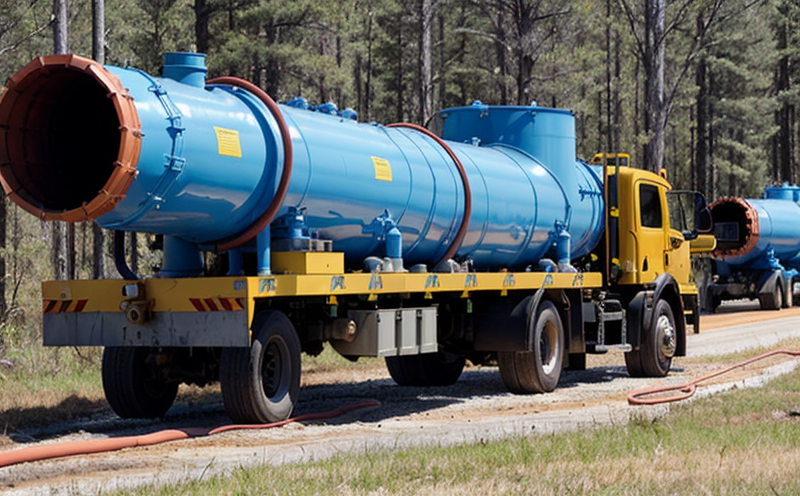ASTM E2105 Infrared Thermography Testing of Gas Pipelines
The ASTM E2105 standard provides a robust framework for the application of infrared thermography (IRT) in inspecting natural gas pipelines. This non-destructive testing method is essential for assessing the integrity of pipeline systems, ensuring they meet regulatory requirements and operational safety standards.
Infrared thermography works by detecting minute surface temperature variations that can indicate potential flaws or weaknesses within a pipeline's structure. These anomalies may arise from manufacturing defects, corrosion, cracks, or other forms of degradation. The primary goal is to detect these issues early, preventing costly repairs, accidents, and disruptions in service.
Gas pipelines operate under high pressure and are susceptible to various types of damage over time. Regular inspections using ASTM E2105 methods can extend the lifespan of pipeline assets by identifying problematic areas before they cause catastrophic failures. This proactive approach aligns with the broader objectives of the power & utilities sector, particularly in ensuring reliable energy distribution.
The ASTM E2105 standard specifies the use of infrared cameras and other thermal imaging devices to capture temperature data across the pipeline surface. The data is then analyzed using calibrated algorithms that help distinguish between normal operational conditions and potential hazards. This process involves several key steps:
- Preparation: Cleaning the pipeline surface to ensure accurate thermal readings.
- Inspection: Conducting a thorough scan of the entire length of the pipeline.
- Data Analysis: Interpreting temperature variations and comparing them against established benchmarks.
- Reporting: Documenting findings and providing recommendations for necessary repairs or maintenance.
The use of ASTM E2105 infrared thermography is particularly advantageous in areas where traditional destructive testing methods are impractical or too costly. By leveraging this non-destructive approach, utilities can maintain high levels of safety while minimizing disruptions to service.
| Aspect | Description |
|---|---|
| Temperature Sensitivity | The ASTM E2105 standard requires the use of cameras capable of detecting temperature differences as small as 0.1°C to ensure accurate assessments. |
| Environmental Factors | Climate and surrounding conditions can affect thermal readings, necessitating adjustments in test protocols to account for these variables. |
| Data Interpretation | Experienced operators are crucial for interpreting the data accurately. They must be trained on both the equipment used and the specific nuances of the pipeline material being inspected. |
The ASTM E2105 method is widely recognized in the power & utilities sector as a reliable means of monitoring natural gas pipelines. By adhering to this standard, companies can ensure that their inspections are consistent and meet the highest industry standards.
Why It Matters
The safety and reliability of natural gas distribution networks are paramount for both utilities and end-users. The ASTM E2105 infrared thermography method is instrumental in maintaining this critical infrastructure by providing early warnings about potential issues within pipelines.
- Preventive Maintenance: Early detection allows for targeted maintenance, reducing the risk of unexpected failures that could impact service.
- Economic Benefits: By avoiding major repairs or replacements, utilities can significantly lower operational costs.
- Regulatory Compliance: Adhering to ASTM E2105 ensures that inspections meet regulatory requirements set by organizations such as the Pipeline and Hazardous Materials Safety Administration (PHMSA).
- User Trust: Demonstrating a commitment to safety through rigorous inspection protocols builds trust with customers and regulators.
The use of ASTM E2105 infrared thermography not only enhances operational efficiency but also contributes to the overall sustainability of natural gas distribution systems. By identifying and addressing potential issues proactively, utilities can ensure that their networks are both safe and reliable for years to come.
Scope and Methodology
The ASTM E2105 standard outlines a comprehensive approach to infrared thermography inspections of natural gas pipelines. This involves several key components:
- Equipment Calibration: Ensuring that all thermal imaging devices are properly calibrated before use.
- Data Collection: Capturing detailed temperature readings across the pipeline's surface.
- Analytical Tools: Utilizing advanced software to analyze collected data and identify potential anomalies.
- Reporting Standards: Documenting findings in a standardized format for easy review by stakeholders.
The ASTM E2105 method emphasizes the importance of accurate calibration, which is critical for obtaining reliable temperature readings. Calibration ensures that all measurements are consistent and comparable across different inspection sessions. This step is particularly important when using multi-camera setups or when comparing results with historical data.
Data collection involves scanning the entire length of the pipeline at various points to capture a comprehensive set of thermal images. The scan must be conducted under controlled conditions, taking into account environmental factors that could influence temperature readings. Once the data has been collected, it is analyzed using specialized software designed to process and interpret infrared images.
The final step in the ASTM E2105 method is reporting the findings in a manner consistent with industry standards. This includes providing detailed descriptions of any anomalies detected along with recommendations for further action or maintenance activities. The report should also include metadata such as the date and time of the inspection, environmental conditions at the time, and the specific thermal imaging equipment used.
Environmental and Sustainability Contributions
The ASTM E2105 infrared thermography method offers several benefits that contribute to environmental sustainability:
- Reduced Carbon Footprint: By identifying and addressing issues early, utilities can prevent the need for more extensive repairs or replacements, which in turn reduces energy consumption during maintenance operations.
- Resource Conservation: Proactive inspections help avoid wasteful use of resources by targeting only those areas that require attention.
- Emission Reduction: Early detection and repair of pipeline leaks can prevent the release of methane, a potent greenhouse gas, into the atmosphere.
- Enhanced Efficiency: By ensuring optimal operating conditions, utilities can improve energy efficiency across their networks.
The ASTM E2105 method is not only beneficial for utilities but also plays a role in reducing the environmental impact of natural gas distribution. Through its emphasis on early detection and targeted maintenance, this standard helps to minimize waste and conserve resources, thereby supporting broader sustainability goals.





